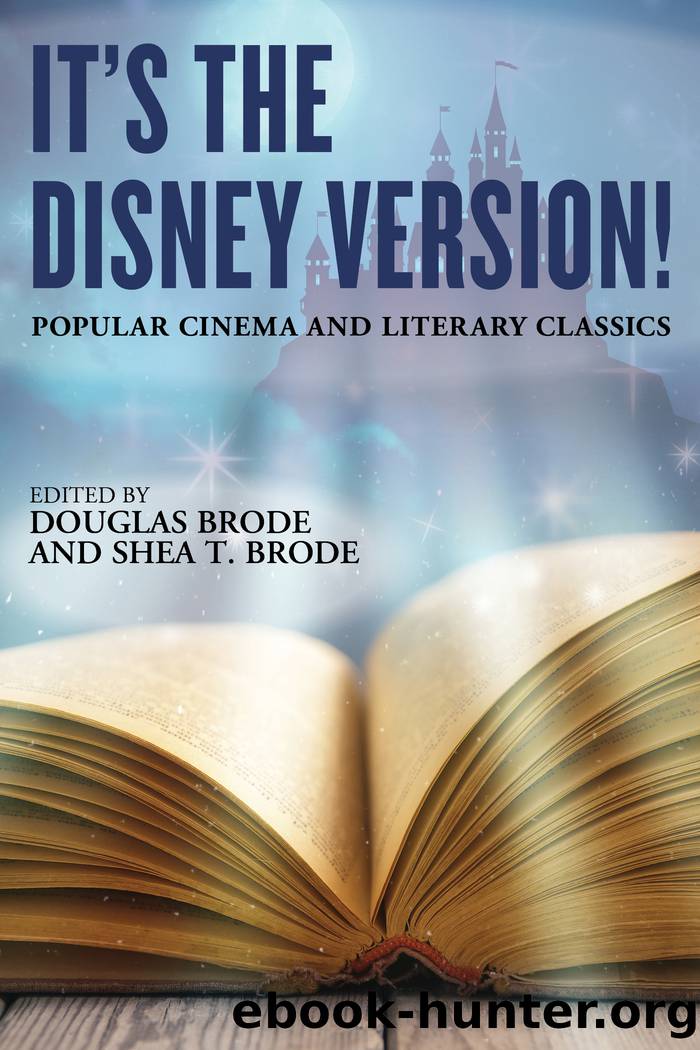It's the Disney Version! by Brode Douglas;Brode Shea T.;

Author:Brode, Douglas;Brode, Shea T.;
Language: eng
Format: epub
Tags: undefined
Publisher: Rowman & Littlefield Publishers
Published: 2012-08-15T00:00:00+00:00
This offers a classic example of function four, âthe villain makes an attempt at reconnaissance.â Seemingly a violation of Proppâs rule of sequence, this proves necessary to prepare for another act of villainy that will set Aurora into a deep sleep. Auroraâs departure offers an extended case of absentation (function one). As a result, the functions themselves are presented here in something other than what is expected to be the ânormalâ order and, momentarily, Peter appears to be posited as the only hero. (Aurora would be a side character, a heroine rather than female hero, the princeâs prize for vanquishing the evil Maleficent.) However, this fails to take into account the manner in which Disneyâs narrative follows Aurora and essentially remains about her until the moment she succumbs to the curse.
In Disneyâs female-oriented variation, Aurora (whom the fairies name Briar Rose, after the parallel character in the Grimm brothersâ version), on the day of her sixteenth birthday, wanders into the forest. Here she meets Prince Phillip. This is not a function, though the encounter becomes important, introducing the ideal of a romantic heterosexual romance. Aurora and Phillip fall in love at first sight, but their love seems less a happy accident than destiny, fated to happen as they were promised to each other at Auroraâs birth. Also, each dreamed of the other long before they met. They dance together to the song âOnce Upon a Dream.â This key sequence foreshadows the ending, suggesting that the love between Phillip and Aurora might be the âtrue loveâ that âconquers allâ and, as such, did not merely happen but was meant to happen, had to happen, was fated to happen.
Still, Disney is far from done with the addition of destiny. The following scene returns us to the house occupied by the three fairies, fed up with trying to make a dress and birthday cake for Aurora in âthe human way.â They lock the doors, close the windows, draw out their wands. Flora and Merryweather argue about the color of the princessâs gown, changing the dress from pink to blue and back again, inadvertently shooting sparks that escape via the chimney. The blue-versus-pink motif is characteristic of the good-natured meddling the fairies (especially Flora and Merryweather) engage in throughout. While they remain deeply committed to sisterhood, (older) women supporting and mentoring other (younger) women, minor moments of conflict do erupt, causing these benign Wiccans to appear relatively realistic rather than sentimental ideals. In this case, the fairiesâ magic has unintended (by them) ill effects that well serve the story line, leading directly to the horrific situation all of the positive characters have been striving to avoid. What seems a simple moment of comedic relief draws the attention of Maleficentâs crow, who reports Auroraâs location to Maleficent.
As in all well-written narratives for children and adults, this provides the necessary turning point required to keep the plot from growing stagnant. Here is the moment when the fairies inform Aurora she is indeed a princess and return her to the castle.
Download
This site does not store any files on its server. We only index and link to content provided by other sites. Please contact the content providers to delete copyright contents if any and email us, we'll remove relevant links or contents immediately.
The Kite Runner by Khaled Hosseini(4952)
Gerald's Game by Stephen King(4374)
Dialogue by Robert McKee(4160)
The Perils of Being Moderately Famous by Soha Ali Khan(4064)
Story: Substance, Structure, Style and the Principles of Screenwriting by Robert McKee(3330)
The 101 Dalmatians by Dodie Smith(3299)
The Pixar Touch by David A. Price(3209)
Confessions of a Video Vixen by Karrine Steffans(3100)
How Music Works by David Byrne(2964)
Fantastic Beasts: The Crimes of Grindelwald by J. K. Rowling(2843)
Slugfest by Reed Tucker(2803)
Harry Potter 4 - Harry Potter and The Goblet of Fire by J.K.Rowling(2801)
The Mental Game of Writing: How to Overcome Obstacles, Stay Creative and Productive, and Free Your Mind for Success by James Scott Bell(2766)
4 - Harry Potter and the Goblet of Fire by J.K. Rowling(2530)
Screenplay: The Foundations of Screenwriting by Syd Field(2435)
Scandals of Classic Hollywood: Sex, Deviance, and Drama from the Golden Age of American Cinema by Anne Helen Petersen(2395)
Wildflower by Drew Barrymore(2378)
The Complete H. P. Lovecraft Reader by H.P. Lovecraft(2366)
Casting Might-Have-Beens: A Film by Film Directory of Actors Considered for Roles Given to Others by Mell Eila(2306)
